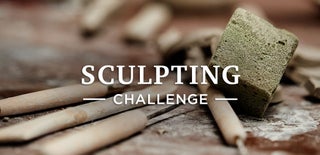Introduction: How to Make and Use 'sprigs' (low Relief Sculpture Moulds Used on Pottery)
A sprig is a low relief clay sculpture that is applied to pottery before firing. The usual technique is to make the relief sculpture from clay or wax, mould it with plaster, then press the final clay into the clay mould before removing and attaching to the pot.
Sprigging was used widely in ancient Roman pottery and some Chinese pottery from the 6th Century AD onwards. It was also used with great effect by Josiah Wedgwood on his amazing Jasperware, often with white cameo figures on a pale blue background.
I came across Wedgwood's sprigs on a visit to the potteries museum in Stoke-on-Trent. I am in my first year of pottery evening classes and thought this was a great technique I could do in my own time at home then take to my class to do the quick mould presses. I can't definitively say that this is how you should do it, but I can say that it works for me.
Of course the sprigs don't have to be used on pottery; you could use them with air or oven hardening clay to make toys/game counters/whatever you like.
Step 1: Tools and Materials
Tools:
Modelling tools
Materials:
Modelling clay
Flat wood/plastic (I used 3mm HPL as that's what I had and it works well as the plaster releases easily)
Plastic/tin container or tin foil
Plaster of Paris or similar casting plaster
Step 2: Get Sculpting
There are a number of ways to get started on your image. I find a good way is to draw a picture on paper to scale first. You could even use a printout of a photo. Then cut around this to make a template. Draw around this template on a suitable sized piece of laminate (wood etc). It should be the right size for the negative mould you want to make, see photos above.
Build up the image little by little with small pieces of modelling clay (it will be helpful to warm the clay first in your hands). Use the tools and shape it to the best of your ability.
Ensure that there are no undercuts in your model that would cause problems in removing your mould. I find that just thinking about whether the mould would pull away cleanly is enough to ensure I avoid undercuts. You can just about see on the model of the 3 cats head shapes that there is a very slight slope in from the bottom to the top. If the slope went the other way then that would be an undercut and would be a big problem.
Step 3: Mould Making
Once you are happy with your sculpture it's time to make the mould. Sadly I haven't taken any photos of this stage, but it's pretty straightforward.
Make a container around the mould the same size as you want the mould to be. You can use old plastic food containers and made reducing walls from clay. I have also made some entirely from aluminium foil and these work great..
Seal the edges of your base and walls with some clay.
Mix up your plaster following the instructions. Ensure it's properly mixed and has no lumps. Before I pour I repeatedly bang the container on the work counter to get rid of bubbles. Pour plaster, then repeatedly tap mould on table to remove more bubbles. When the bubbles stop coming, leave it alone.
Allow the plaster to set for 45 minutes before removing the mould. It won't be fully cured for 48 to 72 hours usually, so don't use it until then.
Step 4: Making Sprigs
If your sprigs are to go on pottery, make sure you have greenware that is still damp enough for attaching pieces.
First of all trim all the rough edges of your mould. You want to ensure it is nice and smooth as you definitely do not want and small bits of plaster getting into your final clay.
Push clay into the mould and force down, smoothing across the top. I find a butter knife is ideal for this.
Allow sprig to dry for a few minutes. The plaster aids this by sucking out water. The sprig will shrink away from the edges of the mould slightly when it's ready.
Removing sprigs from the plaster mould is a bit tricky. I use the flat side of a butter knife. Here is a great video from the Wedgwood museum demonstrating.
Step 5: Using Sprigs
Relatively thin sprigs can be stuck onto greenware using water alone. For heavier pieces I tend to use slip. Once I've stuck sprigs on I cover the piece with plastic for a couple of days and treat as I would a handle added to a cup.
Once your sprigged piece is dried you can treat it in any of the usual ways; painted with underglaze on greenware like the sausage roll above, dipped in slip for a smoothing finish like the scary me-faced oil lamp above, or painted with underglaze after bisque firing like the Germanic me demonstrating my home made bottle opener to my Germanic wife on the musical beer stein above (it's a long story...).
As I said previously, I've only been doing pottery evening classes for a year so my stuff is still a bit on the crummy side but it's coming along.

Participated in the
Sculpting Challenge











